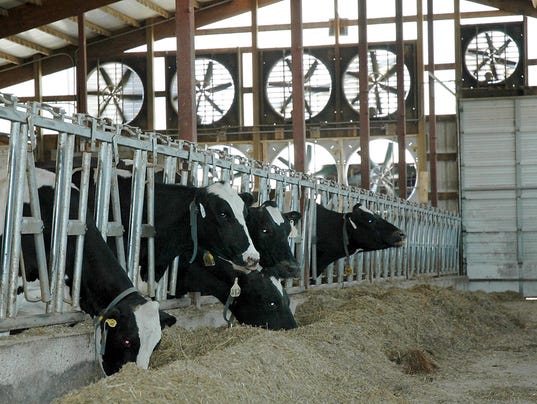 Bolstering a dairy farm’s bottom line involves convincing cows to consume proper amounts of the feed on their plate.
Bolstering a dairy farm’s bottom line involves convincing cows to consume proper amounts of the feed on their plate.
Since both management and facilities issues can cause factors that negatively influence feed intake, a closer look at each may be necessary, Dr. Dan McFarland, PennState Extension, told listeners during a recent webinar.
His list of manageable factors that limit feed intake includes feed bunks standing empty for an unacceptable amount of time, as well as cows not being around to eat. Typically, they’re spending too much time in the milking center.
If feed is present, it may be just out of the cow’s reach or she’s not inclined to eat it because it is of poor or variable quality.
A cow’s appetite is also affected with she is sick or not feeling well, McFarland added, and her drive to visit the feeding area will diminish if she’s lame or injured.
Another consideration is the quality of the cow’s drinking water. “Does dry matter intake drive water intake, or does water intake drive dry matter intake?,” he questioned. “Either way, if poor quality drinking water is offered, the cow’s water intake will likely suffer.”
Overcrowding is another common issue. Not only does it reduce the amount of feed and resting space available to each cow, but the animals occupying the lower rungs of the group’s social ladder shoulder greater negatives regarding feed intake.
Facility concerns
Facilities can contribute to issues that undermine feed intake.
Elevated levels of moisture, gases and other pollutants in the air can affect animal health and crank up heat stress during hot weather. Heat stress adversely affects feed intake and metabolic status, resulting in greater tendency for disease, McFarland pointed out.
Uncomfortable resting area or freestalls that do not allow the cow to use them easily will typically lead to more lameness and dirtier conditions. Slippery floors make cows move gingerly and can cause falls and serious injury.
Limiting the number of drinking water units or making them difficult to drink from can influence feed intake, as does feeding areas that are hard to get to and, therefore, can lessen a cow’s desire to use them for those profitable bites of feed.
Cows tend to drink water soon after eating and after being milked, McFarland said, with studies indicating 30-50 percent of total water intake occurs soon after milking.
Research suggests providing enough drinking water space so 20-50 percent of the group can drink at the same time, and spacing drinking units so cows are no further than 50 feet from water.
McFarland advised a minimum of two water stations per group, providing about 3.5 inches of accessible perimeter per cow. Each unit should allow multiple cows to drink at the same time and, since cows can drink up to five gallons per minute, be able to supply 6-10 gallons of water per minute.
Feed access & availability
The feeding area should provide a comfortable feeding experience for the cows and convenient management for the caretaker. The design should both encourage and allow proper dry matter intake for each cow, make feed available and adequate, and be easy to clean and keep clean.
The physical and social components create an environment that should provide an adequate amount of time to feed, drink and rest, so the cow can consume the proper amount of dry matter so she can be healthy and productive, McFarland noted.
He advised limiting the time cows spend away from the pen to less than three hours a day and making cows and feed available to each other at least 21 hours a day.
For all the cows in a group to eat at the same time, provide at least 27 to 30-inches of linear feed space per cow. With good TMR, good access and time management, 18 inches per cow is considered the absolute minimum, McFarland said.
Locating crossovers every 60 to 80 feet, or every 15 to 20 stalls, gives cows easier access to the feed alley and results in more uniform feed consumption. This fits in nicely with the 50-foot water spacing recommendations, McFarland noted.
“Proving a convenient path between feed, water and the resting area seems like a good formula for influencing good feed intake,” he observed.
With flat mangers, it’s important to push feed up regularly on keep it within the cows’ reach. One successful strategy is half-hour push-ups for two hours after feed delivery, but McFarland advised each farm’s timing be guided by regular observation.
A quality resting area offers many benefits, including reduced stress on feet, less injuries, cleaner cows, increased longevity and improved milk production.
The easiest ways to improve resting area performance is to modify the stall structure to allow more freedom of use, improve resting surface comfort, use more bedding more frequently, groom stalls more frequently, and don’t overcrowd the group.
Design and management matters
The design and management of each component in a dairy shelter influences a cow’s willingness and ability to consume dry matter. Fortunately, McFarland said, most existing facility components that negatively influence feed intake can be improved.
“Good management may be able to overcome poor design, but good design does not make up for poor management,” he added. “Good management is always a key ingredient for success.”
For additional information, layouts, suggested freestall dimensions and features, and other “Idea Plans”, visit Penn State Agricultural and Biological Engineering Extension website.
Source: Wisconsin State Farmer









